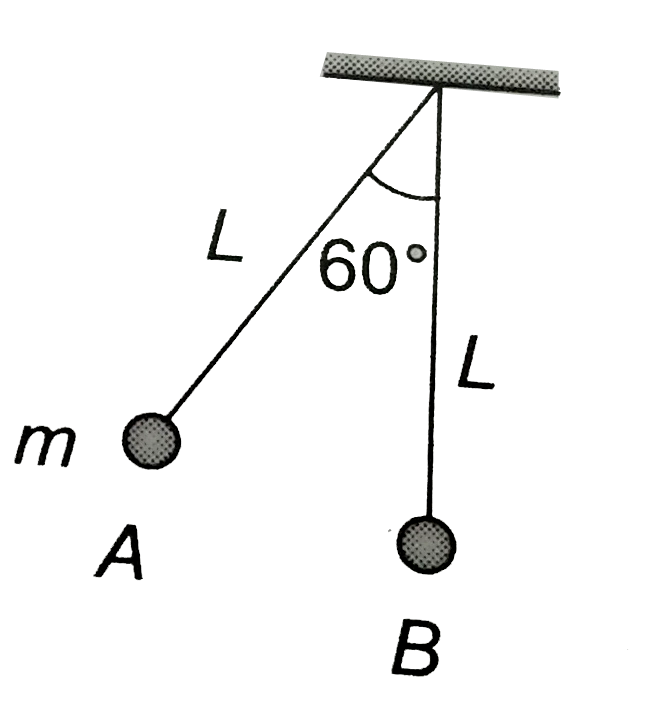A ball A of mass 0.2 strikes another ball B of unknown mass at rest . If the ball A makes an elastic head on collision and then rebounds at one half of its original speed , then calculate the mass of ball B .
To solve the problem step by step, we will use the principles of conservation of momentum and the properties of elastic collisions.
Step 1: Define the variables
Let:
- Mass of ball A, mA=0.2kg
- Mass of ball B, mB (unknown)
- Initial velocity of ball A, uA=u (unknown)
- Initial velocity of ball B, uB=0m/s (at rest)
- Final velocity of ball A after the collision, vA=−u2 (rebounds at half its original speed)
- Final velocity of ball B after the collision, vB (unknown)
Step 2: Apply the conservation of momentum
According to the law of conservation of momentum:
Initial momentum=Final momentum
This can be expressed as:
mAuA+mBuB=mAvA+mBvB
Substituting the known values:
0.2u+0=0.2(−u2)+mBvB
This simplifies to:
0.2u=−0.1u+mBvB
Rearranging gives:
0.2u+0.1u=mBvB
0.3u=mBvB(1)
Step 3: Use the properties of elastic collisions
In an elastic collision, the relative velocity of separation is equal to the relative velocity of approach:
vB−vA=−(uA−uB)
Substituting the known values:
vB−(−u2)=−(u−0)
This simplifies to:
vB+u2=−u
Rearranging gives:
vB=−u−u2=−3u2(2)
Step 4: Substitute equation (2) into equation (1)
Now, substitute vB from equation (2) into equation (1):
0.3u=mB(−3u2)
This simplifies to:
0.3u=−32mBu
Dividing both sides by u (assuming u≠0):
0.3=−32mB
Rearranging gives:
mB=−0.3×23=−0.63=−0.2kg
Since mass cannot be negative, we take the absolute value:
mB=0.6kg
Final Answer
The mass of ball B is 0.6kg.
---
Let:
- Mass of ball A, mA=0.2kg
- Mass of ball B, mB (unknown)
- Initial velocity of ball A, uA=u (unknown)
- Initial velocity of ball B, uB=0m/s (at rest)
- Final velocity of ball A after the collision, vA=−u2 (rebounds at half its original speed)
- Final velocity of ball B after the collision, vB (unknown)
According to the law of conservation of momentum:
Initial momentum=Final momentum
This can be expressed as:
mAuA+mBuB=mAvA+mBvB
Substituting the known values:
0.2u+0=0.2(−u2)+mBvB
This simplifies to:
0.2u=−0.1u+mBvB
Rearranging gives:
0.2u+0.1u=mBvB
0.3u=mBvB(1)
In an elastic collision, the relative velocity of separation is equal to the relative velocity of approach:
vB−vA=−(uA−uB)
Substituting the known values:
vB−(−u2)=−(u−0)
This simplifies to:
vB+u2=−u
Rearranging gives:
vB=−u−u2=−3u2(2)
Now, substitute vB from equation (2) into equation (1):
0.3u=mB(−3u2)
This simplifies to:
0.3u=−32mBu
Dividing both sides by u (assuming u≠0):
0.3=−32mB
Rearranging gives:
mB=−0.3×23=−0.63=−0.2kg
Since mass cannot be negative, we take the absolute value:
mB=0.6kg
The mass of ball B is 0.6kg.
Topper's Solved these Questions
- BOOK - MODERN PUBLICATIONCHAPTER - WORK, ENERGY AND POWER EXERCISE - Objective Type Questions (A. Multiple Choice Questions)29videos
WORK, ENERGY AND POWER
- BOOK - MODERN PUBLICATIONCHAPTER - WORK, ENERGY AND POWER EXERCISE - Objective Type Questions (B. Multiple Choice Questions)46videos
WORK, ENERGY AND POWER
- BOOK - MODERN PUBLICATIONCHAPTER - WORK, ENERGY AND POWER EXERCISE - Revision Exercise (Long Answer Questions)9videos
WORK, ENERGY AND POWER
- BOOK - MODERN PUBLICATIONCHAPTER - WAVESEXERCISE - CHAPTER PRACTICE TEST14videos
WAVES
Similar Questions
A ball of 0.1 kg makes an elastic head on collision with a ball of unknown mass that is initially at rest. If the 0.1kg ball rebounds at one third of its original speed, what is the mass of the other ball?
View SolutionA steel ball of mass 0.5 kg is dropped from a height of 4 m on to a horizontal heavy steel slab. The collision is elastic and the ball rebounds to its original height.
Calculate the impulse delivered to the ball during impact.View Solution
Knowledge Check
- Question 1 - Select One
A ball of mass 10kg strikes another ball of mass 25kg at rest. If they separated in mutually perpendicular directions then the coefficient of restitution is:
A1025B2510C1D0.8 - Question 2 - Select One
A ball of mass M strikes another smooth ball of mass m at rest. If they separate in mutually perpendicular directions, then the coefficient of impact (e) is :
AMmBmMCm2MDZero - Question 3 - Select One
A ball P of mass 2kg undergoes an elastic collision with another ball Q at rest. After collision, ball P continues to move in its original direction with a speed one-fourth of its original speed. What is the mass of ball Q ?
A0.9 kgB1.2 kgC1.5 kgD1.8 kg
Ball A of mass m strickes a stationary ball B of mass M and undergoes an elastic collision. After collision bill A has a speed one third of its initial speed. The ratio of M/m is
View SolutionA particle of mass m1 makes a head on elastic collision with another stationary body of mass m2, If m1 rebounds with half of its original speed then (m1m2) is
View SolutionA particle of mass m1, makes a head on elastic collision with another stationary body of mass m2 If m1, rebounds with half of its original speed then (m1m2) is
View SolutionThe ball A is reached and it makes head on collision with B. The masses of A and B are same
 View Solution
View SolutionA ball of mass 4 kg moving on a smooth horizontal surface makes an elastic collision with another ball of mass m at rest in the line of motion of first ball. If after collision first ball moves in the same direction with one fourth of its velocity before collision, then mass of second ball is
View Solution

